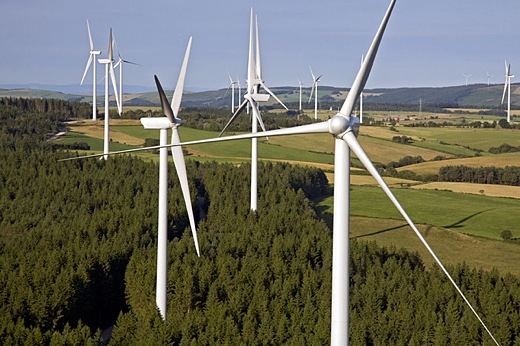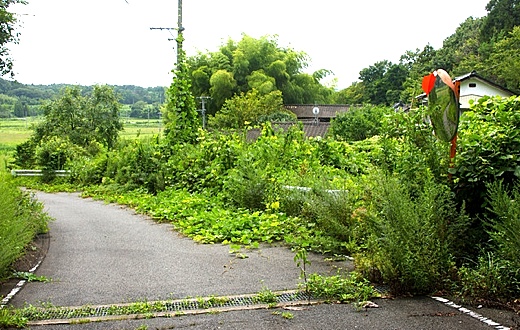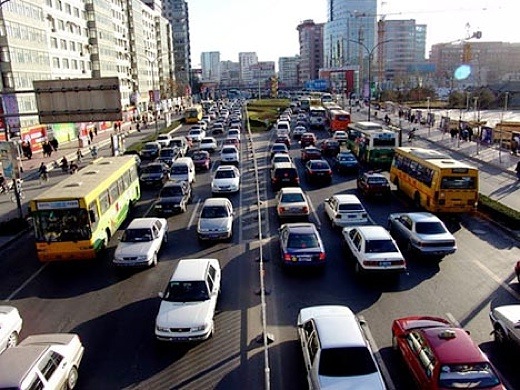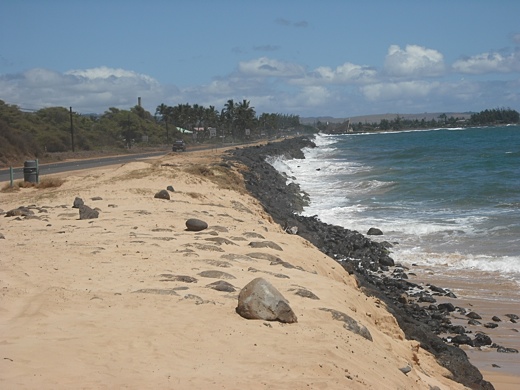SUBHEAD: Utilities giving away power as wind and sun generated energy flood European grid.
By Kari Lundgren on 30 September 2011 for Bloomberg News -
(http://www.bloomberg.com/news/2011-09-29/utilities-giving-away-power-as-wind-sun-flood-european-grid.html)

Image above: Wind turbines operate on EDF Energies Nouvelles SA's 87-megawatt Salles-Curan wind farm in the department of l'Aveyron, France. From original article.
The 15 mile-per-hour winds that buffeted northern Germany on July 24 caused the nation’s 21,600 windmills to generate so much power that utilities such as EON AG and RWE AG had to pay consumers to take it off the grid. Rather than an anomaly, the event marked the 31st hour this year when power companies lost money on their electricity in the intraday market because of a torrent of supply from wind and solar parks. The phenomenon was unheard of five years ago. With Europe’s wind and solar farms set to triple by 2020, utilities investing in new coal and gas-fired power stations no longer face stable returns.
As more renewables come on line, a gas plant owned by RWE or EON that may cost $1 billion to build will be stopped more often from running at full capacity. It may only pay for itself on days like Jan. 31, when clouds and still weather pushed an hour of power on the same-day market above 162 ($220) euros a megawatt-hour after dusk, in peak demand time. “You’re looking at a future where on a sunny day in Germany, you’ll have negative prices,” Bloomberg New Energy Finance chief solar analyst Jenny Chase said about power rates in wholesale trading. “And a lot of the other markets are heading the same way.”
Europe’s biggest power markets give preference to renewable energy including forcing some utilities to use their fossil-fuel plants less. That cuts into profit, complicating investment decisions as the companies try to meet emission targets and replace older plants and networks that Citigroup Inc. estimates will cost them more than 900 billion euros by 2020.
Profit Margins
Northern Europe’s renewable-energy goals call for about 200 gigawatts of solar and wind capacity by 2020, or almost a third of the current installed base, compared with about 70 gigawatts today, according to the Finnish energy consultant Poyry. Even by 2014, gross profit from burning coal in Germany may skid by as much as 41 percent, according to Barclays Plc. The gross margin at a coal power plant after deducting fuel and emission permit costs, the so-called clean dark spread, may “collapse” to as low at 3.50 euros a megawatt-hour, Barclays analysts including Peter Bisztyga said in a Sept. 1 report.
The spread was at 6.15 euros today, Bloomberg data show. Narrower margins mean it will take longer for companies to pay off building new gas- and coal-fired facilities. Those plants are needed. They can run around the clock, preventing blackouts when the sun sets or the wind dies as European power demand grows 5 percent through 2015 compared with 2010, according to Paris-based bank Societe Generale SA’s forecast.
Squeezed Out
“The more intermittent technology like renewables, the more baseload generation will be squeezed out,” Volker Beckers, chief executive officer of RWE’s U.K. Npower unit, said in an interview at Bloomberg’s London bureau. Npower’s plants are largely coal- and gas-fired, or baseload, meaning they can run around the clock. Electricite de France SA is spending 6 billion euros on its new 1,650-megawatt nuclear reactor at Flamanville in Normandy.
Dong Energy A/S, Denmark’s biggest utility, inaugurated its first power station in the U.K. in February, an 824-megawatt combined-cycle gas turbine plant for 600 million pounds. Europe’s main utilities index has fallen 15 percent this year. RWE shares have retreated 44 percent since January and traded at 27.76 euros at 4:16 p.m. in Frankfurt. EON has slumped 28 percent since January and announced plans last month to cut 10 percent of its workforce and reduce dividends.
EON, RWE
EON will miss its 2015 forecast by about 3 percent for earnings of 13.3 billion euros to 13.8 billion euros before interest, tax, depreciation and amortization if average power prices are 57.30 euros a megawatt-hour, below EON’s forecast of 60 to 62 euros, UniCredit analyst Lueder Schumacher said. At 58.50 euros, RWE’s recurring net income will be 2.2 billion euros in 2013, compared with the German utility’s forecast of 2.5 billion, he estimated. “Too much wind can depress power prices, but then there are times when very little wind is blowing,” Poyry Director Phil Hare said in a telephone interview. Based on weather patterns over the past 10 years, there’s a 72-hour period each year when a wind farm would produce less than 5 percent of its potential output, Hare said. “Some other plant has to be there, but the company has to make the return on its investment in just those 72 hours over 10 years.”
Hedging Power Output
Germany’s renewable energy boom will make hedging the power output for utilities’ coal and natural-gas plants “more and more difficult,” according to an executive at Edison Trading SpA speaking at a conference in London. The country’s renewable energy output may rise to 200 terawatt-hours in 2020 from 120 terawatt-hours last year, Andrea Siri, Edison’s head of continental power and origination, said yesterday, citing a regulatory forecast.
Solar plants in Germany generated as little as 23.8 megawatts at 7 a.m. Berlin time yesterday compared with 11,570 megawatts at 1:30 p.m., according to a European Energy Exchange AG’s website, tracking power capacity. A steady supply of 1,000 megawatts is enough for about 2 million homes in Germany. Power prices on the Epex Spot SE exchange in Paris that handles German and French supply vary hour-by-hour depending on how available capacity is. At times they can become negative when renewable energy peaks and there’s a surplus of power.
Take Renewable Output
At such times, generators or the grid operator pay consumers to take their electricity if they aren’t able to reduce output or hedge it. Grid operators in Germany, Europe’s biggest power market, are also required to take renewable output if it is available, just as in Spain and France. The highest-ever hourly price in the combined German-French intraday market was 162.06 euros a megawatt-hour for delivery between 6 p.m. and 7 p.m. in Germany on Jan. 31, while the lowest was minus 55.11 euros for 2 p.m. to 3 p.m. on Feb. 6, data from the exchange showed. The negative German prices on July 24 occurred on a day when winds averaged 15 mph in the northern state of Mecklenburg- Western Pomerania, home to many wind farms, Bloomberg weather data show. Germany’s same-day electricity price was below zero for nine hours on that windy day on July 24, with negative prices for a total of 31 hours so far in 2011, according to Epex data. France had 9 negative hours this year.
Buffer the Volatility
The joint French-German intraday market started last year and has so far helped to “buffer the volatility of prices,” Epex company spokesman Wolfram Vogel said by e-mail on Sept. 16. “The law in Germany is that renewables have priority, so utilities have the choice of turning plants down for a few hours or paying a negative price to someone in Germany or abroad,” EON spokesman Georg Oppermann said in a telephone interview. The company’s traders can protect EON against losses by watching weather patterns, he added. “The huge amount of renewable capacity due to be added to the grid will depress not just spreads but also the outright power price,”
UniCredit analyst Scott Phillips said. “This is clearly a negative predominantly for all thermal power plants, particularly coal.” Britain plans to install more than 8,000 offshore wind turbines by 2020 to get 15 percent of electricity from renewable sources. Germany installed 7.4 gigawatts of solar photovoltaic capacity last year, the most of any nation, driving total capacity to 17,200 megawatts. Spain aims to get 20.8 percent of its total energy from marine energy, geothermal and offshore wind projects, as well as hydropower, by 2020.
Negative Prices
German wind power capacity peaked at close to 12,000 megawatts on July 24, according to Meteogroup data, the last day of negative prices. Four days later, the most that the country’s wind parks generated was 315 megawatts. Photovoltaic and solar-thermal plants may meet most of the world’s demand for electricity by 2060 -- and half of all energy needs -- with wind, hydropower and biomass plants supplying much of the remaining generation, the International Energy Agency said in August. U.K. energy regulator Ofgem is considering paying generators to keep plants open as back-up suppliers, compensating them for down time. The so-called capacity payments, which also are being studied in Germany, are likely to favor gas over coal, as gas plants can be turned on and off faster, according to Phillips.
Feed-In Tariffs
Subsidized power rates called feed-in tariffs, a proposed carbon floor price in Britain and other measures favoring renewable projects will lead to a shift in the “merit order” of plants across Europe, he said. Power from renewable projects will be the first to be used, followed by gas-fired power plants, which release less carbon-dioxide than coal stations. “Margins are going to get worse over the next few years but as the value of the plant for backup starts getting interest, it becomes an issue of what they’re worth, not what they cost,” Hare said.
.
By Kari Lundgren on 30 September 2011 for Bloomberg News -
(http://www.bloomberg.com/news/2011-09-29/utilities-giving-away-power-as-wind-sun-flood-european-grid.html)

Image above: Wind turbines operate on EDF Energies Nouvelles SA's 87-megawatt Salles-Curan wind farm in the department of l'Aveyron, France. From original article.
The 15 mile-per-hour winds that buffeted northern Germany on July 24 caused the nation’s 21,600 windmills to generate so much power that utilities such as EON AG and RWE AG had to pay consumers to take it off the grid. Rather than an anomaly, the event marked the 31st hour this year when power companies lost money on their electricity in the intraday market because of a torrent of supply from wind and solar parks. The phenomenon was unheard of five years ago. With Europe’s wind and solar farms set to triple by 2020, utilities investing in new coal and gas-fired power stations no longer face stable returns.
As more renewables come on line, a gas plant owned by RWE or EON that may cost $1 billion to build will be stopped more often from running at full capacity. It may only pay for itself on days like Jan. 31, when clouds and still weather pushed an hour of power on the same-day market above 162 ($220) euros a megawatt-hour after dusk, in peak demand time. “You’re looking at a future where on a sunny day in Germany, you’ll have negative prices,” Bloomberg New Energy Finance chief solar analyst Jenny Chase said about power rates in wholesale trading. “And a lot of the other markets are heading the same way.”
Europe’s biggest power markets give preference to renewable energy including forcing some utilities to use their fossil-fuel plants less. That cuts into profit, complicating investment decisions as the companies try to meet emission targets and replace older plants and networks that Citigroup Inc. estimates will cost them more than 900 billion euros by 2020.
Profit Margins
Northern Europe’s renewable-energy goals call for about 200 gigawatts of solar and wind capacity by 2020, or almost a third of the current installed base, compared with about 70 gigawatts today, according to the Finnish energy consultant Poyry. Even by 2014, gross profit from burning coal in Germany may skid by as much as 41 percent, according to Barclays Plc. The gross margin at a coal power plant after deducting fuel and emission permit costs, the so-called clean dark spread, may “collapse” to as low at 3.50 euros a megawatt-hour, Barclays analysts including Peter Bisztyga said in a Sept. 1 report.
The spread was at 6.15 euros today, Bloomberg data show. Narrower margins mean it will take longer for companies to pay off building new gas- and coal-fired facilities. Those plants are needed. They can run around the clock, preventing blackouts when the sun sets or the wind dies as European power demand grows 5 percent through 2015 compared with 2010, according to Paris-based bank Societe Generale SA’s forecast.
Squeezed Out
“The more intermittent technology like renewables, the more baseload generation will be squeezed out,” Volker Beckers, chief executive officer of RWE’s U.K. Npower unit, said in an interview at Bloomberg’s London bureau. Npower’s plants are largely coal- and gas-fired, or baseload, meaning they can run around the clock. Electricite de France SA is spending 6 billion euros on its new 1,650-megawatt nuclear reactor at Flamanville in Normandy.
Dong Energy A/S, Denmark’s biggest utility, inaugurated its first power station in the U.K. in February, an 824-megawatt combined-cycle gas turbine plant for 600 million pounds. Europe’s main utilities index has fallen 15 percent this year. RWE shares have retreated 44 percent since January and traded at 27.76 euros at 4:16 p.m. in Frankfurt. EON has slumped 28 percent since January and announced plans last month to cut 10 percent of its workforce and reduce dividends.
EON, RWE
EON will miss its 2015 forecast by about 3 percent for earnings of 13.3 billion euros to 13.8 billion euros before interest, tax, depreciation and amortization if average power prices are 57.30 euros a megawatt-hour, below EON’s forecast of 60 to 62 euros, UniCredit analyst Lueder Schumacher said. At 58.50 euros, RWE’s recurring net income will be 2.2 billion euros in 2013, compared with the German utility’s forecast of 2.5 billion, he estimated. “Too much wind can depress power prices, but then there are times when very little wind is blowing,” Poyry Director Phil Hare said in a telephone interview. Based on weather patterns over the past 10 years, there’s a 72-hour period each year when a wind farm would produce less than 5 percent of its potential output, Hare said. “Some other plant has to be there, but the company has to make the return on its investment in just those 72 hours over 10 years.”
Hedging Power Output
Germany’s renewable energy boom will make hedging the power output for utilities’ coal and natural-gas plants “more and more difficult,” according to an executive at Edison Trading SpA speaking at a conference in London. The country’s renewable energy output may rise to 200 terawatt-hours in 2020 from 120 terawatt-hours last year, Andrea Siri, Edison’s head of continental power and origination, said yesterday, citing a regulatory forecast.
Solar plants in Germany generated as little as 23.8 megawatts at 7 a.m. Berlin time yesterday compared with 11,570 megawatts at 1:30 p.m., according to a European Energy Exchange AG’s website, tracking power capacity. A steady supply of 1,000 megawatts is enough for about 2 million homes in Germany. Power prices on the Epex Spot SE exchange in Paris that handles German and French supply vary hour-by-hour depending on how available capacity is. At times they can become negative when renewable energy peaks and there’s a surplus of power.
Take Renewable Output
At such times, generators or the grid operator pay consumers to take their electricity if they aren’t able to reduce output or hedge it. Grid operators in Germany, Europe’s biggest power market, are also required to take renewable output if it is available, just as in Spain and France. The highest-ever hourly price in the combined German-French intraday market was 162.06 euros a megawatt-hour for delivery between 6 p.m. and 7 p.m. in Germany on Jan. 31, while the lowest was minus 55.11 euros for 2 p.m. to 3 p.m. on Feb. 6, data from the exchange showed. The negative German prices on July 24 occurred on a day when winds averaged 15 mph in the northern state of Mecklenburg- Western Pomerania, home to many wind farms, Bloomberg weather data show. Germany’s same-day electricity price was below zero for nine hours on that windy day on July 24, with negative prices for a total of 31 hours so far in 2011, according to Epex data. France had 9 negative hours this year.
Buffer the Volatility
The joint French-German intraday market started last year and has so far helped to “buffer the volatility of prices,” Epex company spokesman Wolfram Vogel said by e-mail on Sept. 16. “The law in Germany is that renewables have priority, so utilities have the choice of turning plants down for a few hours or paying a negative price to someone in Germany or abroad,” EON spokesman Georg Oppermann said in a telephone interview. The company’s traders can protect EON against losses by watching weather patterns, he added. “The huge amount of renewable capacity due to be added to the grid will depress not just spreads but also the outright power price,”
UniCredit analyst Scott Phillips said. “This is clearly a negative predominantly for all thermal power plants, particularly coal.” Britain plans to install more than 8,000 offshore wind turbines by 2020 to get 15 percent of electricity from renewable sources. Germany installed 7.4 gigawatts of solar photovoltaic capacity last year, the most of any nation, driving total capacity to 17,200 megawatts. Spain aims to get 20.8 percent of its total energy from marine energy, geothermal and offshore wind projects, as well as hydropower, by 2020.
Negative Prices
German wind power capacity peaked at close to 12,000 megawatts on July 24, according to Meteogroup data, the last day of negative prices. Four days later, the most that the country’s wind parks generated was 315 megawatts. Photovoltaic and solar-thermal plants may meet most of the world’s demand for electricity by 2060 -- and half of all energy needs -- with wind, hydropower and biomass plants supplying much of the remaining generation, the International Energy Agency said in August. U.K. energy regulator Ofgem is considering paying generators to keep plants open as back-up suppliers, compensating them for down time. The so-called capacity payments, which also are being studied in Germany, are likely to favor gas over coal, as gas plants can be turned on and off faster, according to Phillips.
Feed-In Tariffs
Subsidized power rates called feed-in tariffs, a proposed carbon floor price in Britain and other measures favoring renewable projects will lead to a shift in the “merit order” of plants across Europe, he said. Power from renewable projects will be the first to be used, followed by gas-fired power plants, which release less carbon-dioxide than coal stations. “Margins are going to get worse over the next few years but as the value of the plant for backup starts getting interest, it becomes an issue of what they’re worth, not what they cost,” Hare said.
.












